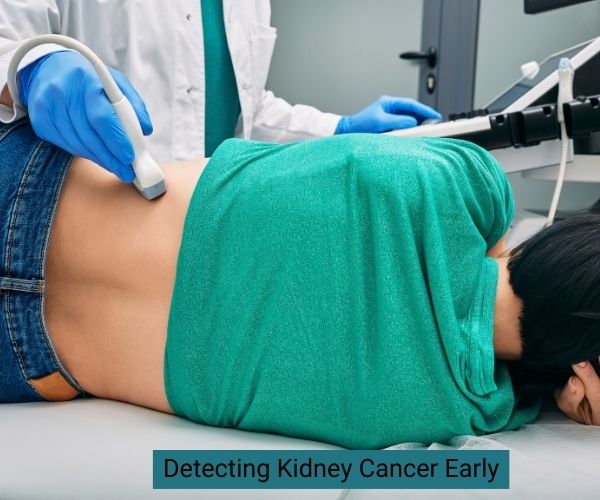Dr Anup Ramani @ Copyright 2024
By Dr. Anup Ramani
Kidney cancer remains one of the most commonly diagnosed cancers worldwide and its incidence is on the rise. Early detection is crucial, as kidney cancer symptoms can often be subtle or overlooked until the disease reaches more advanced stages. Regular annual health check-ups can play a pivotal role in identifying kidney issues before they develop into more serious conditions, including kidney cancer.
In cities like Mumbai, where healthcare advancements are at the forefront, Kidney Cancer treatment has evolved significantly and robotic kidney surgery is now one of the most effective, Minimal invasive options. However, even the most advanced surgical techniques, such as Robotic Radical Nephrectomy, are more successful when paired with early detection through regular check-ups.
This article explores the importance of annual health check-ups in preventing kidney cancer, how these check-ups aid in early diagnosis and the role they play in promoting kidney health.
Why is Early Detection Important?
Kidney cancer originates in the kidneys, where abnormal cell growth forms a tumor. Renal cell carcinoma is the most common type and it typically presents with no noticeable symptoms in the early stages. This makes early detection crucial, as it allows for intervention before the cancer spreads or becomes more difficult to treat.
Kidney cancer is often diagnosed through imaging techniques, such as ultrasound, CT scans or MRI, during routine health check-ups. Without these tests, kidney cancer may remain undetected until it progresses, potentially reducing the chances of a successful treatment outcome. Early-stage kidney cancer, however, can often be treated effectively with minimal invasive surgery for kidney cancer, leading to a much higher survival rate.

How Do Annual Health Check-ups Help Prevent Kidney Cancer?
Regular health check-ups provide an essential opportunity for early detection of kidney cancer through several means:
- Blood Tests and Kidney Function Monitoring:
Routine blood tests are a standard part of annual check-ups and can detect abnormalities in kidney function. High levels of creatinine or blood urea nitrogen (BUN) in the blood may indicate kidney dysfunction, which could be linked to an underlying condition such as kidney cancer. Early detection of these signs allows for prompt investigation and treatment before more severe symptoms appear. - Imaging and Screening for Kidney Tumors:
Imaging tests, such as ultrasound, CT scans or MRIs, are often performed during annual check-ups to monitor kidney health and detect any abnormalities, such as cysts or tumors. If a potential kidney tumor is identified, a biopsy may be performed to determine if it is malignant. Detecting a kidney tumor at an early stage significantly increases the likelihood of a successful Kidney Tumor Surgery improves overall prognosis. - Urine Tests:
Urine tests can reveal important indicators of kidney health. For instance, blood in the urine or abnormal protein levels may be signs of kidney issues, including cancer. Urinalysis as part of an annual check-up can help detect these issues before they lead to more serious conditions. - Monitoring Risk Factors:
Regular check-ups allow doctors to track risk factors associated with kidney cancer. These include hypertension, obesity, smoking and a family history of kidney disease or cancer. By identifying and managing these risk factors, doctors can help prevent kidney cancer from developing or catching it in its earliest stages, where treatment outcomes are more favorable.
What Our Patients Are Saying
What Are the Benefits of Early Kidney Cancer Detection through Health Check-ups?
The advantages of early detection through annual health check-ups extend beyond simply diagnosing kidney cancer earlier. These benefits include:
- Higher Survival Rates:
When kidney cancer is detected at an early stage, before it spreads beyond the kidneys, treatment options such as robotic kidney surgery are more effective. Early-stage kidney cancer typically has a better prognosis and patients can often return to normal activities sooner. - Minimal Invasive Treatment Options:
Early detection increases the likelihood of being eligible for minimal invasive surgery for kidney cancer. Techniques uses small incisions and robotic precision, can be applied in the early stages of cancer. These surgeries have faster recovery times and reduced complications compared to traditional open surgeries. - Better Treatment Planning:
Regular check-ups allow healthcare providers to track a patient’s health over time. This longitudinal data enables doctors to tailor the treatment approach based on an individual’s specific risk factors, genetics and kidney health, ultimately improving treatment outcomes. - Reduced Healthcare Costs:
Catching kidney cancer early means less extensive treatment is required, which often translates into lower overall healthcare costs. In contrast, waiting for symptoms to worsen can lead to more complex and costly treatments.
Why Should You Get Annual Health Check-ups for Kidney Cancer Prevention?
For most adults, annual check-ups should begin at age 40 or earlier if there is a family history of kidney cancer or related conditions. Kidney Cancer treatment in Mumbai is rapidly evolving and healthcare providers strongly recommend early screenings for those with a higher risk.
Individuals at-risk include:
- People with a family history of kidney cancer or other cancers
- Individuals with high blood pressure or chronic kidney disease
- Smokers and those with a history of smoking
- Obese individuals or those with poor metabolic health
In these cases, kidney cancer screenings may start earlier, typically around age 35-40 and can be more frequent. It’s crucial to discuss individual health risks with a healthcare provider to determine the optimal screening schedule.
How Does Robotic Kidney Surgery Fit into the Prevention Strategy?
While robotic kidney surgery is primarily a treatment option, its role in prevention should not be overlooked. Here’s how it fits into the overall kidney cancer prevention strategy:
- Minimal Invasive Surgery: In cases where kidney cancer is detected at an early stage, robotic surgery for kidney cancer offers a Minimal invasive treatment approach. The use of small incisions and robotic precision allows for faster recovery, minimal scarring and fewer complications, making it ideal for treating early-stage kidney cancer.
- Precision and Safety: Robotic platforms allow surgeons to remove tumors with precision, preserving as much healthy kidney tissue as possible. This helps maintain kidney function while ensuring complete removal of the tumor.
- Post-Surgery Monitoring: After surgery, patients can be closely monitored using annual health check-ups to ensure no recurrence of cancer and to maintain optimal kidney health.
Conclusion
Annual health check-ups are critical for the early detection and prevention of kidney cancer. By identifying potential risks and catching the disease in its early stages, Kidney Cancer treatment becomes more effective, leading to better patient outcomes and lower treatment costs. Regular check-ups not only help with the early diagnosis of kidney tumors but also allow healthcare providers to monitor kidney function, manage risk factors and provide personalized treatment options.
In Mumbai and across India, where robotic kidney surgery has become a standard treatment method, annual health check-ups enable patients to take advantage of these advanced treatments early, ensuring the best possible prognosis. Preventive healthcare, including regular screenings and check-ups, plays an essential role in combating kidney cancer and promoting long-term kidney health.
FAQs
How often should I get kidney cancer screenings?
For most adults, annual health check-ups are recommended, starting at age 40. However, individuals with higher risk factors, such as a family history of kidney cancer or chronic kidney disease, may need to start earlier or have more frequent screenings.
What are the signs of kidney cancer?
Early-stage kidney cancer often has no symptoms. However, as it progresses, symptoms like blood in the urine, persistent back pain, fatigue and unexplained weight loss may appear.
What tests are included in an annual check-up for kidney cancer prevention?
Routine tests may include blood tests (for kidney function), urine tests (to check for blood or protein) and imaging tests like ultrasounds, CT scans or MRIs.
How does robotic kidney surgery work for cancer treatment?
Robotic kidney surgery uses small incisions and advanced robotic systems to remove kidney tumors with precision. It minimizes trauma, reduces recovery time and preserves kidney function.
Can annual health check-ups prevent kidney cancer?
While check-ups cannot guarantee the prevention of kidney cancer, they are vital for early detection, which can significantly improve treatment outcomes and survival rates.
About Author

Uro-Oncological & Robotic Surgeon
Dr. Anup Ramani is a robotic uro-oncological surgeon and an internationally recognized expert in robotic surgery for prostate, kidney and urinary bladder cancers. With more than two decades of robotic experience and 2,000+ robotic procedures, he brings unmatched precision and outcomes to complex uro-oncology cases. He is widely published in his field and is known for a personal, transparent approach-often spending over an hour in initial consultations to educate patients on its disease, surgery and recovery. His expertise spans prostate cancer treatment, kidney and bladder cancer surgery, adrenal gland surgery, kidney stone treatment, penile cancer surgery and enlarged prostate management. Dr. Ramani advocates the advantages of robotic surgery-magnified 3D vision, tremor-filtered precision, minimal scarring, lower blood loss and faster recovery-helping patients return to life sooner.
Table of Contents
Recent Blogs
Best Uro-Oncological surgeon
Specialist in India for Robotic Surgery
MCh, DNB, MS, DNB
Dr. Anup Ramani
CONTACT
Uro-Oncologist in India,
Best Robotic Surgeon for Uro Oncology Surgery
1407, One Lodha Place Next to World Towers Senapati Bapat Marg, Worli, Mumbai. 400013.
Dr Anup Ramani @ Copyright 2024 – Website Maintenance, SEO & GEO by Opal Infotech
- Partial penectomy is done in cases where glans and distal penis is involved with carcinoma.
- Partial penectomy is a type of organ-preserving surgery. Preservation of sexual and micturational function depends on the surgical dissection and reconstruction of residual urethra.
- Patients who develop stones in the kidney or ureter, often experience severe pain.
- This condition usually needs a procedure to remove the kidney stones.
- This procedure is called ureteroscopy and is performed very commonly.
- It does not require any cuts and hence it is painless.
- The procedure is performed with an endoscope inserted through the penis under spinal anesthesia.
- The scope is inserted through the penis into the kidney and stones are dissolved with a laser.
- The procedure takes about 40-50 minutes.
- A catheter (urine pipe) is kept after the procedure to drain the bladder. A stent is kept in the kidney at the same time.
- Patient is mobile and walking in the room the same evening.
- Hospital stay is one night and patient is discharged the next day after removal of the catheter.
- Patient has to come back after six weeks to remove the stent in the kidney.
- Patients can resume office a week after surgery and heavy activities like running, weight lifting, a month after the procedure.
- We offer fixed packages for this procedure which can be obtained by calling our helpline +91 9967666060.
- Men with an enlarged prostate, which is a normal ageing changes, often experiencing difficulty passing urine. This condition usually needs a procedure to trim the prostate and relieve the blockage.
- This procedure is called TURP and is performed very commonly.
- It does not require any cuts and hence it is painless.
- The procedure is performed with an endoscope inserted through the penis under spinal anaesthesia.
- The overgrown prostate is dissolved with a laser bloodlessly.
- The procedure takes about 40 minutes.
- A catheter (urine pipe) is kept after the procedure to drain the bladder.
- Patient is mobile and walking in the room the same evening.
- Hospital stay is two nights and patient is discharged with the catheter, which is removed after 4 days.
- Patients can resume office a week after surgery and heavy activities like running, weight lifting, a month after the procedure.
- We offer fixed packages for this procedure which can be obtained by calling our helpline +91 9967666060.
-
Robotic adrenalectomy is a sophisticated, complex surgery and it is very important that an experienced surgeon performs this surgery to avoid major complications.
-
Once the anesthesia is done, and patient positioned, three micro cuts (3mm each) are made in the patient’s abdomen.
-
The arms of the Da Vinci robot are connected to the cuts via ports (tubes).
-
Dr. Ramani then sits in the controlling console to perform the surgery.
-
On an average, a robotic adrenalectomy takes one hour.
-
The surgery is almost completely bloodless and there has never been any need to transfuse blood after surgery.
-
A urine catheter and bag to drain the bladder is inserted during surgery.
-
A tiny drain pipe may be inserted in the surgical side of the abdomen, connected to a bag.
-
Patient is kept nil-by-mouth the day of the surgery, with IV fluids. Sips of water are started the next day and solid food by day three.
-
The drain pipe, if kept, is removed in the room on day 2 after surgery.
-
The catheter is removed on day two after surgery.
-
Total hospital stay for robotic adrenalectomy is 4 nights (including night before surgery).
-
Post discharge, a doctor from the surgical team visits the patient at home/ hotel room once every day.
On the day of discharge, patient is totally self-sufficient. They are able to walk freely without any pain, dress themselves, shower, toilet and they do not need to hire any nurse or help at home. Almost all patients are back to work within 2 weeks of surgery.
Heavy activities like running, weight lifting can be resumed after a month
Follow up after an adrenalectomy is in the form of CT scans, once a year for 5 years.
Local patients usually meet Dr. Ramani after two weeks to discuss report.Outstation patients are counselled on a phone consultation.
- Dr. Ramani is one of the very few surgeons in India who has the expertise to perform a robotic surgery for bladder cancer, which includes removing the urinary bladder and reconstructing a new bladder robotically.
- Robotic radical cystectomy is an extremely sophisticated, complex surgery and it is very important that an experienced surgeon performs this surgery to avoid major complications.
- Once the anaesthesia is done, and patient positioned, six micro cuts (3mm each) are made in the patient’s abdomen.
- The arms of the Da Vinci robot are connected to the cuts via ports (tubes).
- Dr. Ramani then sits in the controlling console to perform the surgery.
- On an average, a robotic radical cystectomy with an ileal conduit takes 3-4 hours.
- The surgery is almost completely bloodless and there has never been any need to transfuse blood after surgery.
- A urine catheter and bag to drain the new bladder is inserted during surgery.
- Two tiny drain pipe in inserted in the surgical side of the abdomen, connected to a bag.
- Patient is kept nil-by-mouth for 4 days after surgery with IV supplementation of patient’s daily requirements of calories, fats, carbohydrates, proteins and electrolytes.
- The drain pipes are removed in the room on day 3-5 after surgery.
- Total hospital stay for radical cystectomy is 8 nights (including night before surgery).
- Post discharge, a doctor from the surgical team visits the patient at home/ hotel room once every day.
- On the day of discharge, patient is totally self-sufficient. They are able to walk freely without any pain, dress themselves, shower, toilet and they do not need to hire any nurse or help at home.
- Almost all patients are back to work within 6 weeks of surgery. Heavy activities like running, weight lifting can be resumed after two months.
Follow up after a radical a cystectomy is in the form of CT scans, once a year for 5 years.
Histopathology report: Local patients usually meet Dr. Ramani after two weeks to discuss report.
Outstation patients are counselled on a phone consult. Depending on the report, patient may or may not need chemotherapy after surgery.
If chemo is needed, patients may choose to get it done with a medical oncologist of their choice or avail the services of one of the four medical oncologists on our team.
- Robotic partial nephrectomy is a sophisticated, complex surgery and it is very important that an experienced surgeon performs this surgery to avoid major complications. Robotic radical (total) nephrectomy is
- relatively easier but still requires significant experience to consistently deliver results.
- Once the anaesthesia is done, and patient positioned, five micro cuts (3mm each) are made in the patient’s abdomen.
- The arms of the Da Vinci robot are connected to the cuts via ports (tubes).
- Dr. Ramani then sits in the controlling console to perform the surgery.
- On an average, a robotic radical nephrectomy takes one hour and a robotic partial nephrectomy takes about an hour and half.
- The surgery is almost completely bloodless and there has never been any need to transfuse blood after surgery.
- A urine catheter and bag to drain the bladder is inserted during surgery.
- A tiny drain pipe in inserted in the surgical side of the abdomen, connected to a bag.
- Patient is kept nil-by-mouth the day of the surgery, with IV fluids. Sips of water are started the next day and solid food by day three.
- The drain pipe is removed in the room on day 3 after surgery. The catheter is removed on day two after surgery.
- Total hospital stay for radical/partial nephrectomy is 4 nights (including night before surgery).
- Post discharge, a doctor from the surgical team visits the patient at home/ hotel room once every day.
- On the day of discharge, patient is totally self- sufficient.
- They are able to walk freely without any pain, dress themselves, shower, toilet and they do not need to hire any nurse or help at home.
- Almost all patients are back to work within 2-3 weeks of surgery.
- Heavy activities like running, weight lifting can be resumed after a month.
- Follow up after a radical/partial Nephrectomy is in the form of CT scans, once a year for 5 years.
- Local patients usually meet Dr. Ramani after two weeks to discuss report.
- Outstation patients are counselled on a phone consultation.





